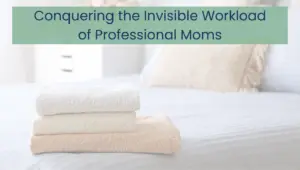Decluttering and getting organized is one of those tasks that’s often easier said than done. Even with the best intentions, many people find themselves repeatedly stalling out, unable to make sustainable progress in their homes.
As a professional home organizer, I’ve worked with countless overwhelmed families to help them overcome the mental and physical barriers to decluttering. Through this experience, five key roadblocks have consistently emerged as the main culprits holding people back.

Obstacle #1: Lack of Time ⏰
Between work, family responsibilities, social commitments, and the general busyness of daily life, many people feel they simply don’t have the time to tackle a big decluttering project. It often gets pushed aside in favor of more “urgent” tasks.
Recommendations to overcome this obstacle
1) Start small: Set aside just 10 minutes, at least 3 days a week. Put it in your calendar and treat it like any other important task or appointment. Even this small amount of time can lead to steady progress.
2) Make it easy: Begin your decluttering efforts with a junk drawer or one box of decorations from the attic. Once you start feeling successful, you’ll build the confidence to tackle larger, more daunting areas of your home.
3) Choose your most productive time: Are you a “morning person” or do you get an energy boost in the afternoons or evenings? Schedule your 10-minute sessions during the time when you’re most likely to be focused and motivated.
4)Declutter during downtimes: Use commercial breaks while watching TV as opportunities to quickly sort through and let go of items.
5) Use a timer and set a goal: Each time you declutter, set a timer for 10 minutes and challenge yourself to remove a specific number of items (e.g., 10 items). This “beat the clock” approach can help you stay focused and make the most of your limited time.
The key is to start small, make it easy on yourself, and be consistent. Over time, those 10-minute sessions will add up, and you’ll start to see progress in your decluttering efforts.
Obstacle #2: Emotional Attachment 💖
The hardest items to let go of are often those with strong sentimental value. Whether it’s your child’s first pair of shoes, Grandma’s vintage china, or a box of old love letters, the emotional weight of these possessions can make decluttering feel downright impossible.
Recommendations to overcome this obstacle
1) Reflect: Ask yourself, “Does this item truly bring me joy, or am I just feeling guilty about letting it go?” If it’s the latter, express gratitude for the memories and then let the item go.
2) Preserve the sentiment: Take a photo of the item to preserve the memory. Remind yourself that the memories you cherish live on, even if the physical object does not.
3) Compromise with 3 favorites: If the idea of an “all or nothing” approach is a barrier, allow yourself to keep only your 3 most meaningful or joyful items. Place the rest in a labeled storage bin. If you don’t need or miss those items in a year, you’ll feel more confident about letting them go.
4) Assign new meaning: Consider repurposing the item or finding a new way to display or use it. This can help create a positive association and make it easier to part with.
5) Share the memories: If letting go feels too difficult, consider passing the item on to a family member or friend who would appreciate it and the story behind it.
The key is to approach each sentimental item with care, empathy, and an open mind. By taking a thoughtful, step-by-step approach, you can overcome the emotional attachment and make progress in your decluttering journey.

Obstacle #3: Overwhelm and Indecision 🤷♀️
For many, the idea of tackling a big, daunting decluttering project is so overwhelming that they never even start. The fear of making the “wrong” decisions or not being able to do it “perfectly” can be crippling, leading to analysis paralysis and inaction.
Recommendations to overcome this obstacle
1) Start small and build confidence: Begin your decluttering efforts with a manageable task, such as a junk drawer or one box of decorations. As you experience the satisfaction of completing these smaller projects, you’ll build the confidence to tackle larger, more daunting areas of your home.
2) Use a decision-making framework: Ask yourself the following questions to help guide your decluttering decisions:
a. Do I use this item regularly? No = let it go!
b. Is it broken or outdated? Yes = let it go!
c. Is it easily replaceable? Yes = let it go!
3) Consider sharing with family: If you’re struggling to part with an item, see if a family member or friend would be willing to take it. If no one else wants it, that’s a strong indication that it’s time to let it go.
4) Embrace the “good enough” mindset: Perfection is the enemy of progress when it comes to decluttering. Remind yourself that your goal is to make steady, incremental improvements, not to achieve a flawless, magazine-worthy result.
5) Take it one step at a time: Break down your decluttering project into smaller, manageable tasks. Focus on completing one area or category at a time, rather than trying to tackle your entire home all at once.
By adopting a more gradual, compassionate approach to decision-making, you can overcome the feelings of overwhelm and indecision that often hold people back from making progress on their decluttering goals.
Obstacle #4: Lack of Family Support 👨👩👦
Decluttering is often a team effort, but not everyone in the household may be on board. Spouses, kids, or other family members who aren’t invested in the process can inadvertently sabotage your efforts, whether consciously or subconsciously.
Recommendations to overcome this obstacle
1) Communicate openly and without judgment: Have an honest, compassionate conversation with your loved ones about your decluttering goals and why it’s important to you. Listen to their concerns and perspectives as well.
2) Make it a family activity: Enlist your family’s help by turning the decluttering process into a collaborative, fun experience. Compromise where needed, and celebrate small wins together. Decluttering is much easier (and more enjoyable) when you have the support of your loved ones.
3) Set a shared family goal: Identify a decluttering-related objective that the entire household can work towards, such as clearing out a specific room or creating more storage space. Celebrate reaching this goal as a family, acknowledging everyone’s contributions.
4) Lead by example: As you make progress in your own decluttering efforts, your family members may gradually become more receptive to the idea. Showcase the benefits you’re experiencing, such as increased productivity, reduced stress, or a greater sense of calm in your home.
5) Suggest a trial run: Propose a temporary, limited-time decluttering challenge that your family can participate in together. This can help them experience the positive impacts firsthand and build momentum for more long-term efforts.
By fostering open communication, shared goals, and a spirit of collaboration, you can overcome the hurdle of lacking family support and make the decluttering process a united, rewarding experience for everyone involved.

Obstacle #5: Bad Habits 🧠
Even with the time, motivation, and family support to declutter, deeply ingrained bad habits around acquiring and maintaining stuff can quickly derail your progress. Impulse purchases, sentimental hoarding, and dropping items anywhere instead of putting them away can undermine all your hard work.
Recommendations to overcome this obstacle
1) Identify your problem areas: Take a close look at your specific decluttering-related bad habits, such as impulse shopping, failing to put items back in their designated homes, or holding onto things out of sentimental attachment. Understanding the root causes of these behaviors is the first step.
2) Implement systems and routines: Once you’ve identified your problem areas, put in place practical solutions to address them. For example, institute a 24-hour “cooling off” period before making non-essential purchases, or create designated storage spaces for commonly used items and make tidying up a part of your daily or weekly rituals.
3) Start small and build momentum: Don’t try to overhaul all your bad habits at once. Focus on making one or two changes at a time, and celebrate your successes. As you experience the benefits of these new habits, you’ll be motivated to tackle additional areas.
4) Enlist accountability partners: Ask your spouse, family members, or friends to support you in breaking your decluttering-related bad habits. Having someone to regularly check in with and provide encouragement can make a significant difference.
5) Be patient and compassionate with yourself: Changing deeply ingrained habits takes time and effort. If you slip up, don’t beat yourself up. Approach it with self-compassion, learn from the experience, and recommit to your goals.
Consistency and a step-by-step approach are key to overcoming the roadblock of bad habits. By implementing practical systems and routines, you can gradually replace undesirable behaviors with more positive, decluttering-friendly habits.
✨ Don’t forget!! – Grab This FREE Guide ✨
Your Handy Companion for Overcoming the 5 Biggest Decluttering Obstacles

Alright, friends, we’ve covered a lot of ground when it comes to the most common roadblocks to decluttering. But don’t worry – with the right mindset and strategies, you’ve got this!
Remember, overcoming these obstacles is all about taking it one step at a time. Start small, celebrate your wins, and don’t be afraid to revisit and refine your decisions as you go. Progress, not perfection, is the name of the game here.
The most important thing is to just get started. Identify the specific challenges holding you back, try out the solutions we discussed, and watch as your decluttering journey starts to unfold. Before you know it, you’ll be well on your way to the calm, organized home of your dreams.
So what are you waiting for, my friends? Grab a box, set a timer, and dive right in.
I know you can do it!!







One Response
Hi, this is a comment.
To get started with moderating, editing, and deleting comments, please visit the Comments screen in the dashboard.
Commenter avatars come from Gravatar.